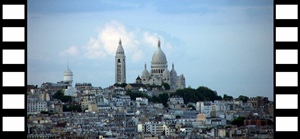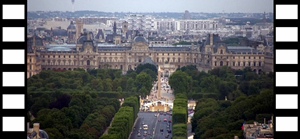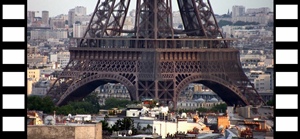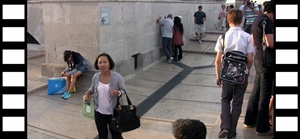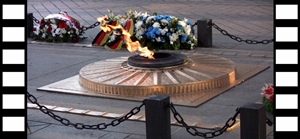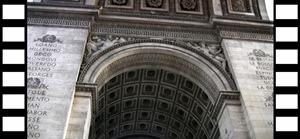The Arc de Triomphe (or less ambiguously, the Arc de Triomphe de l'Étoile) is a famous
Parisian landmark that was built to commemorate French military successes, originally
those occurring during the Revolutionary and Napoleonic wars. Construction was begun
under Napoleon in 1806, but was suspended after Napoleon's first abdication in 1814.
It didn't resume until 1833, during the reign of Louis Philippe, and was completed in
1836. The arch was modeled after the ancient Arch of Titus in Rome, but is much
larger. The Arc de Triomphe is 164 feet tall, 148 feet wide and 72 feet deep. It is
covered with reliefs, sculptures and inscriptions celebrating French military prowess.
The most famous of the sculptures is called The Departure of 1792, or La Marseillaise,
by François Rude. Many of the inscriptions are names of battles in which France was
victorious during the Revolution and the reign of Napoleon, and others are names of
generals of the time. The arch is located at the center of the Place Charles de
Gaulle (once called the Place de l'Étoile), where it is surrounded by a busy
roundabout with twelve streets radiating from it. One of these streets is the
Champs-Elysées, which ends at the arch.

Bob and Arch

Arch and Street Sign

Relief - The Battle of Aboukir

Sculpture - The Triumph of 1810
Sculpture - La Marseillaise
Having just walked the length of the Champs-Élysées, we were interested in visiting the
arch. Seeing the arch just across the roundabout from anywhere along the edge of the
square, one is tempted to just make a mad dash across the roundabout and hope for the
best. But for those whose plans don't include premature death, this course of action
is not recommended. Instead, there are two underpasses which make the traversal much
safer. We found one of them after a little searching and crossed over to the arch.
Entry to the arch was covered by our Museum Passes and we ascended to a small museum
located in the "attic" of the arch. Here we found a model of the arch, a life-size
copy of a detail from the La Marseillaise sculpture, and a
memorial to French soldiers who fought in World War I.

Model of Arch

Detail from La Marseillaise (copy)
We continued to the top of the arch in hopes of finding a good view, and we were not
disappointed. The arch is the tallest structure in the vicinity, so there are
unobstructed views in all directions. We could see things like the Eiffel Tower, the
Sacré-Coeur basilica and (of course) the Champs-Élysées. And opposite the
Champs-Élysées we could see its continuation, a street called the Avenue de la Grande
Armée, which leads toward a modern business district called La Défense which features
an angular 1980's-style arch of its own.
Things to See

North of Champs-Élysées, Sacré-Coeur

Sacré-Coeur, Montmartre

Avenue des Champs-Élysées

Louvre, Champs-Élysées, Notre-Dame

Eiffel Tower

Nella and Eiffel Tower

Eiffel Tower

Avenue de la Grande Armée and La Défense
Église Saint-Augustin, Nella Atop Arch
After getting our fill of the view, we returned down the staircase to street level and
looked at the Tomb of the Unknown Soldier beneath the arch, the resting place of an
unidentified soldier from World War I, and its eternal flame.
Tomb of the Unknown Soldier

Tomb of the Unknown Soldier

South Half of Arch
Our next stop was the nearby Charles de Gaulle Étoile Metro station, where we bought
some tickets (there are several options, among them single trip passes, day passes
and a discounted set of ten single trip passes called a carnet - we bought a
carnet, as we figured we'd have ample opportunity to use the remaining tickets) and
boarded a Metro train which took us (after a couple of transfers) to the Odéon
station near our hotel. We found a nearby Chinese/Vietnamese fast food place for
dinner and returned to our hotel room to recover from the activities of our first
full day in Paris. And we would need the rest, as we had an appointment the next
morning with this tower...
French Vietnamese Food









